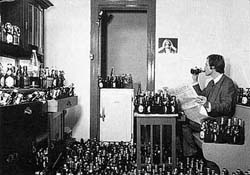
Reuters reported on a Finnish study which found that living in closer proximity to a bar may increase the likelihood of becoming a heavy drinker and engaging in risky alcohol behavior. The study followed 54,778 Finnish adults over seven years, and found that a person who moved one kilometer (0.6 mile) closer to a bar had a greater odd of becoming a heavy drinker by 17%. A heavy drinker is defined as drinking more than 10 ounces a week of distilled alcohol for a man, and drinking more than seven ounces of distilled alcohol a week for a woman.
Professor Jussi Vahtera of Turku University reports that the alcohol-induced mortality rate of men and women living alone rose steeply after the decrease in the price of alcohol in 2004. In the last two decades, the number of alcohol-related diseases and alcohol poisoning have doubled among the Finnish working-age population.
The study took place between 2000-2009, and included responses from 78,000 people who responded to at least one survey, and 54,778 responses from people who responded to at least two surveys.
According to the cross-sectional findings, the likelihood of an extreme drinking occasion (one that results in a pass out from alcohol use) and heavy use was higher among those that resided less than a kilometer away from a bar verses those who lived more than a kilometer away from a bar.
Lead researcher Jaana L. Halonen, of the Finnish Institute of Occupational Health in Kuopio, responded in an email, “Factors other than proximity are also likely to explain the observed association.” She noted that one possibility could be that drinkers choose to live closer to bars. The study also looked at a subset of people who did not move, but bars came closer to them, and found that the findings were similar among those individuals, too.
Of the people who lived an average of 0.12 kilometers from a bar, just over 9% of those individuals were categorized as being a heavy drinker. Those who lived about 2.4 kilometers, or 1.5 miles, away from a bar, about 7.5% of those people were considered a heavy drinker.
While the association was modest, Holonen commented that even a modest association between access to bars and being a heavy drinker is “notable.”
For any one person, Halonen said, the risk of becoming a problem drinker depends on a whole range of factors. She added that, it is possible restricting bars’ hours could limit the local people’s risky drinking.
The study conducted entirely in Finland many not account for how the findings would apply to other countries, as Halonen said, drinking habits and the “cultural norms” will vary by country. For instance, she notes that, “in the UK and Australia, heavy drinking is reported to be more common than in Finland, whereas in the USA it is less common.”
In the USA, the prevalence of binge drinking is about 17.1%, according to analyzed data collected in 2010 by the Center for Disease Control.